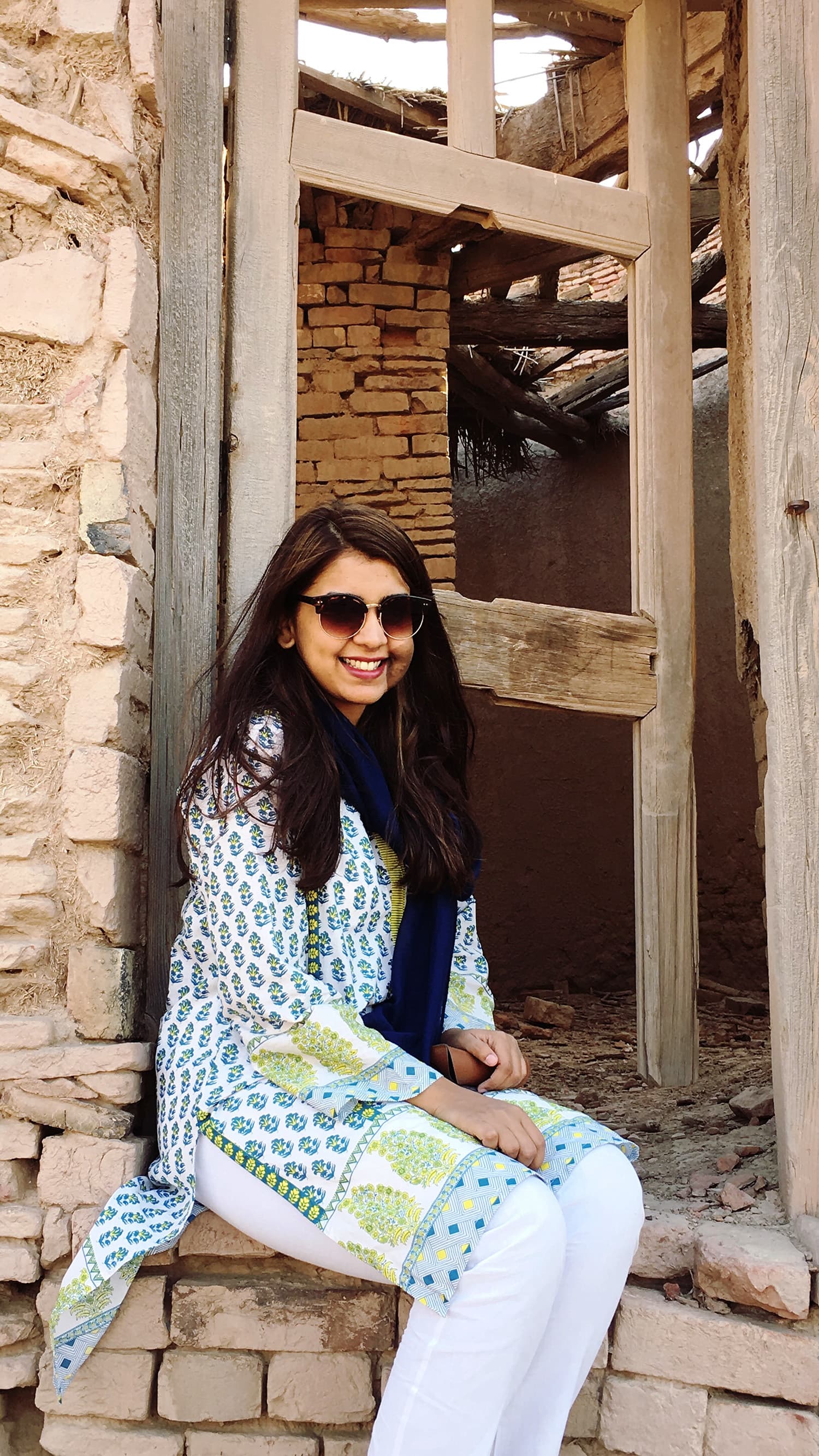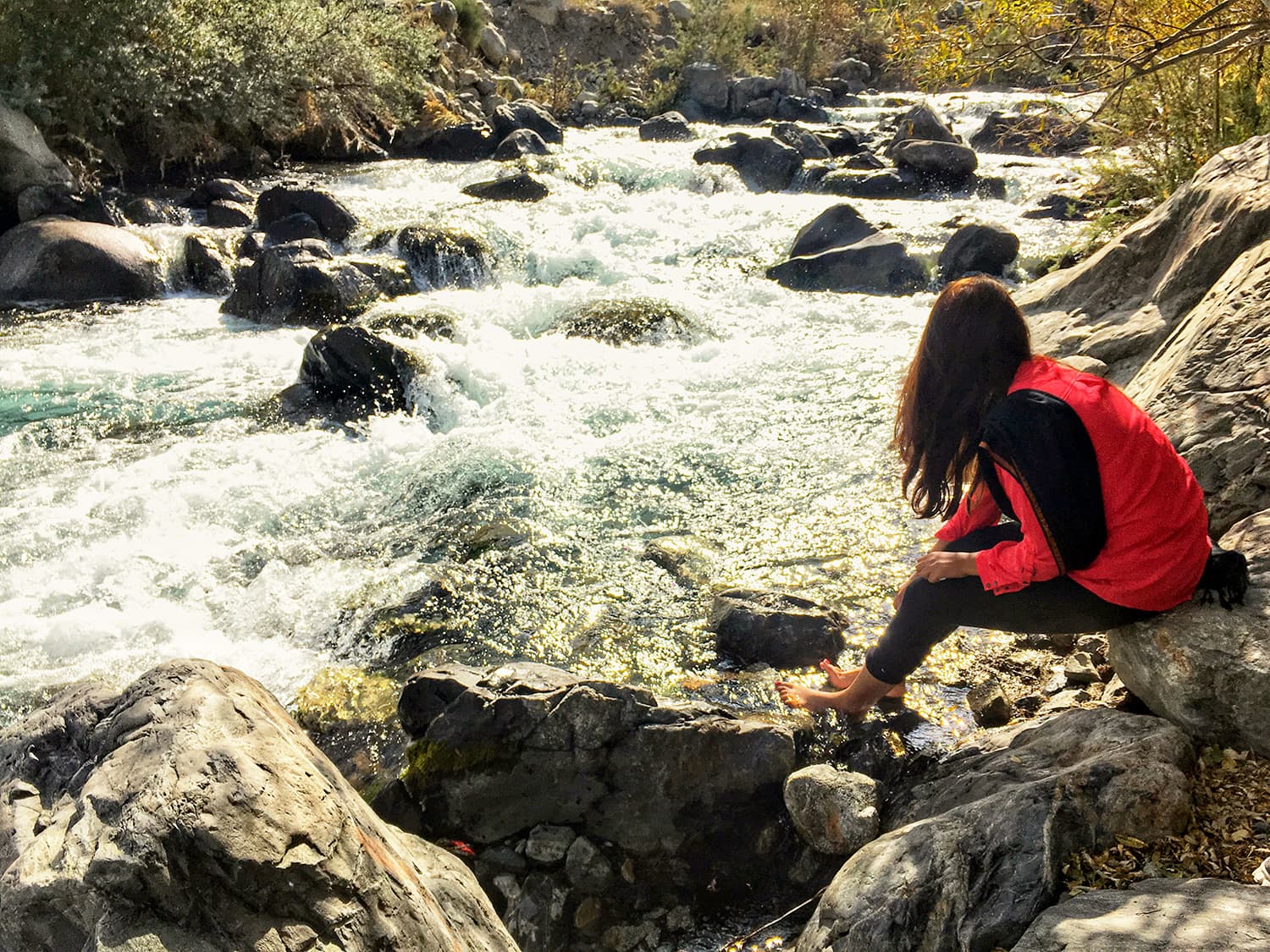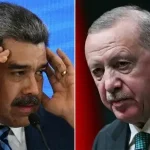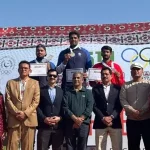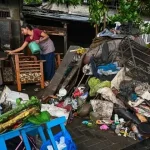’m not a traveller. And this is not a regular travel blog.
This is my journey of losing myself, so that I could eventually find myself, richer and fuller.
A while ago, I was broke, heartbroken and in a desperate need to get away from Karachi, a city which offers no respite.
It’s the only place I have ever called home. But this city is not easy. And if you’re cracked open and vulnerable, Karachi is definitely not the place to be.
This realisation dawned on me one evening, as I sat by the sea, watching the sun go down. It was the greyest sunset ever.
The cloudless sky was grey; the water was grey. The sand on the beach, the buildings, the birds, the roads, the crabs – all grey.
Grey. Old. Senile. Diseased. Dying? I hoped not. I prayed not.
A line from one of Jason Silva’s documentaries flashed in my mind, where he quoted Geoffrey West from the Santa Fe Institute, saying:
“Cities are like organisms, alleys are like capillaries.”
The choked vessels of this city would eventually lead to a heart attack.
I felt understood by no one. There was chaos within. I was spread too thin. I was being consumed, spent, silently withering away.
Too polluted to breathe properly. The noise made it hard for me to hear myself. The traffic – oh, the traffic jams were maddening.
This city reminds me, every day, to give. It’s a city that has given off itself and has held people in.
Give, give, give. I gave with whatever I had. Time, energy, mind, soul. It just never seemed enough.
At work, I was trying to put up a brave face – smile wide, say yes, push through – one more day, one more week, just another month.
Every morning began with a pep talk: “You can do it. You can get by one more day without breaking down, without falling to pieces. You can make it through.”
At home, the emptiness would nibble away on my insides, “You’re not enough, you’re never going to be enough!”
I had been living my dream of travelling alone vicariously, through the life of someone who perhaps saw me as an opportunity rather than a partner.
I allowed myself to take pride in his travels and stories as if they were my own. But they weren’t.
I would have liked to share those experiences, but perhaps, he didn’t like the same. And so when we chose our different paths, it broke me down in half.
For the first time, it dawned on me that I was only partly myself with him. In living my dreams through him, I was only living half of my own dreams.
I wasn’t allowing myself to grow in those areas where he filled in the voids. I shrank myself in his presence, rather than letting the relationship build me stronger.
Despite being a strong and independent woman, I somehow believed deep down that I was never going to be as good as him. I gave him power over me, and with time, he no longer had an interest in my life.
I dreamed of open skies and being wild and free. But I felt stuck to the ground. And at the end of the day, I felt inadequate and incomplete.
Some days were better than others. I felt lighter that morning. I had gone to the salon the evening before, and changed around my hair a bit.
I felt bold and glamorous. I put on some makeup, a brighter shade of lipstick to match my spirits, and I left the house without really knowing where I was going.
I ran a few errands, and then drove down to Sea View towards Do Darya, singing along to songs that soothed my soul.
A crashed blue Honda caught my eye on the opposite side of the road. It looked like it was brand new. Did they survive? I hope they did. Bless their souls.
There was something about that car that felt strangely familiar. In retrospect, it was definitely an omen – shiny, brand new, and on the verge of a crash down.
I thought I’d drive down to the water, sit by the sea at my usual spot, but the heat that day was sweltering, the sun stinging my skin where my hands touched the steering wheel.
A little further down, a tiny green dome caught my attention.
I had seen it from distance quite a few times, but that day something urged me to go see it up close. Is that a mazaar?
Perhaps. There were strings of little flags alongside the dirt-road that led to the gates.
It wasn’t a mazaar, I realised, as I drove closer. Masjid-e-Arafat, read the sign outside. Would it be okay for me to go in? I’m dressed in a t-shirt and yoga pants, which is certainly not the appropriate attire for a mosque.
I sat in my parked car right outside the gates, contemplating whether I should go in or not. I could see hundreds of pigeons flying around the mosque in circles. I even saw some chickens pecking around inside.
Surely, there must be someone who takes care of the mosque and the birds, but I couldn’t see anyone through the gates.
After a few minutes of sitting there in the heat, my curiosity got the best of me.
I got out of the car and walked up to the rusted, green iron gates, which appeared to be locked from the inside. I was about to turn back, when I heard a man call out:
“Chota darwaza khula hai, andar aajao” (The smaller gate is open, come in). A middle-aged man in brown shalwar kameez limped towards the gate, asking me in.
Feeling sheepish for being caught prying, I walked in hesitantly, knowing that it was too late to turn back.
“Don’t worry, come in. It’s okay,” he reassured.
As I walked in, a strange tranquility took over me. It felt like time had paused in this place. The sound of the fluttering wings of the birds and the cooing pigeons under the cool shade of the trees felt starkly different from the noise of the impatient traffic and the unforgiving heat outside.
“Feel free to spend as much time here as you want.”
I wasn’t expecting that. I wasn’t expecting that I’d be allowed in, let alone welcomed inside a mosque.
Women aren’t always welcomed this way inside holy places. They must cover their heads and hide behind veils or use the side doors to enter.
Why wasn’t this person judging me?
“This mosque was built by a sufi saint in the 80s. This is a spiritual place which calls people in. Only the ones truly seeking peace and connection come here. You must be looking for something. Would you like some tea?”
Humbled and spellbound, I shook my head. I asked for some water instead.
I walked up the steps to a small, white-washed terrace in the patio, and as soon as I was alone, tears started streaming down my face uncontrollably.
This place was indeed drenched in divine spirituality; I could sense it with each breath. I sat under the shade of the tree, trying to hold on to the magic of this moment, this sense of peace.
Dildar Baba, the caretaker of this soulful place, came to the terrace with a glass of water, careful not to disturb me in my moment of prayer.
As I sat there talking to him, he told me that the saint who built this mosque was an avid traveller.
That he drove a jeep not just on land but also in water, through the ocean waves, which is why he was popularly known as Samundari Baba.
That he was a free-spirited man who liked to spend his time in solitude, praying here unperturbed by worldly desires.
Samundari Baba gathered many devotees over his lifetime, and he has a mazaar near Nooriabad, where his jeep is still parked.
Dildar Baba’s words piqued my interest. The picture he painted was drastically different from the image of holy men I had in my mind.
Samundari Baba seemed to have lived the kind of life I secretly desired, but never had the courage to openly admit to myself.
Free-spirited, soulful wanderer. That’s what I want to be.
But I’m a woman, a voice in my head protested.
Does that really matter?
Should it matter? Another voice asked.
It shouldn’t. No. It really shouldn’t.
Well then. Someone has to take the first step.
But how?
With a meagre bank account and pending bills to pay, how could I indulge in these pursuits? Plus, my calendar at work was pretty much filled for the next few weeks.
I couldn’t just leave. Could I?
And where would I go anyway? Who would I go with? Who would I go to? Alone. I felt so deeply alone. Yes, I had friends. And family. But I needed to heal. And I needed to do that on my own.
My mind was being rational, steering me towards caution. My soul, on the other hand, craved freedom.
Wind-in-my-hair, driving-fast-going-nowhere type of freedom. There must have been a million reasons to stay, but there was only one reason not to: The Voice inside me urged me to go.
In a moment of impulse, before I could talk myself out of it, I booked myself a train ticket to the first city that came to my mind: Bahawalpur.
I had never been to that city and I didn’t know anyone there. I just remembered reading about its rich history and culture. It sounded like a great place to start.
I had only been on a Pakistani train once in the last 20 years, and that too with 26 other people I knew.
Alone? On a train? A woman?
The Voice said: Trust me. Go for it.
So I did.
Travelling alone is strangely liberating. You feel more alive. You get to set your own pace. You get to choose how far to push yourself.
Travelling alone as a woman in this country is somehow synonymous with bold and brave. Everywhere I went, every person I met in the week to follow, reminded me of that.
While there are obvious reasons to be cautious and wary, there are also multiple advantages of travelling alone as a woman in this country.
A couple of days before leaving, I looked up hotels and guest houses in Bahawalpur and made a reservation over the phone at a small and cheap hotel. All they asked me was my name and number of persons.
Upon hearing that I was travelling alone, they bumped me up to an executive suite.
With a hotel room and a one-way ticket to a city I knew little about, I was all set to start my journey – the journey of redefining my boundaries and shedding my inhibitions.
On a Friday night, I packed my bags and left for Cantt Station with a flutter in my heart. I can’t believe I am actually doing this.
If I was scared, I tried not to show it. I took a deep breath and opened the door to my train compartment. A middle-aged couple. That’s not too bad.
They welcomed me in with a warm smile and asked me where I was going.
“Bahawalpur? Great. We are going there too. Don’t worry about anything. You’re a lot like our daughter.”
Over the next 10 hours, we shared stories and we shared food. We talked about our families and our take on the situation of the country.
There were three other young men in the compartment, but they sat in the corridor for most of the journey. They let us to take whichever berth we were most comfortable on, and were courteous and accommodating.
As all six of us got off at the same station, the men held doors open for us and helped us with our luggage.
There are definite advantages of travelling alone as a woman.
As we were leaving the station, the couple asked me if I had someone picking me up. When I told them that I didn’t know anyone here, they insisted that I come with them.
They wouldn’t take no for an answer. “We said that you’re like our daughter. How can we leave you here by yourself?”
As someone who advocates for safety, precaution and for making detailed plans and schedules, doing something without a plan or surety was undoubtedly refreshing.
Not knowing where I would go or what the next hour would look like, allowed me to trust my intuition.
They seemed genuine and trustworthy, so I went ahead and loaded my luggage into their car. I arrived at their relatives’ house, who greeted me like they had known me for a long time.
They offered me a hearty breakfast and a room to rest in. I felt like their Guest of Honour.
Strange. Very strange. 12 hours after I left home, I found myself sitting in a stranger’s house in a new city, feeling completely at ease.
Their warmth, hospitality and inclusiveness were truly humbling. Unpretentious, non-judgmental – they were as they were.
They didn’t give with the hope of getting something in return. They just gave because they had no fear of losing anything.
Bahawalpur is a small city. I realised that the hotel I had booked for myself was only a 10-minute walk down the road.
Although my hosts offered me to stay for as long as I wished, I preferred to head my own way. I couldn’t wait to explore this spectacular city.
I found my hotel to be more comfortable than I had imagined, which was wonderful considering that it wasn’t too heavy on the pocket.
Since Uber or Careem have not yet started their services in Bahawalpur, I wondered what would be the best option to go around the city.
I decided to walk down to the street to see for myself. I couldn’t spot any taxis. Rickshaws it was, then.
It was only after I had gone around the entire city that I wondered why rickshaws weren’t my first preference.
After all, I wanted the wind-in-my-hair, driving-fast-going-nowhere type of freedom. Rickshaws offered exactly that.
Moreover, each rickshaw driver brought their own uniqueness when being my tour guide.
Travelling frees you from the traps of your own mind. It helps you connect with the bright-eyed, curious child that you may have forgotten still lives inside you.
It doesn’t matter where you go, as long as you allow yourself to engage with the world like you’re seeing it for the first time.
Bahawalpur is full of surprises. It felt like stepping into a different era. The stunning architecture and the majestic beauty blew me away.
I’m surprised at the fact that such few people know about the gems this city holds.
My first stop was the Central Library and the Bahawalpur Museum right next to it. I certainly did not expect to be greeted by the sparkling Rolls Royce at the entrance!
We fight for public spaces in Karachi; here, I walked into the Central Library and saw young people, albeit a few, lazing around in the lawn outside or sitting in a quiet corner in the main hall, actually reading for pleasure.
With high arches and columns bathed in pure white, the Central Library is an intricately detailed work of art which embodies grandeur and thoughtfulness.
It houses more than 100,000 books, audio-visual archives, as well as local and national newspaper archives dating back a century.
The caretaker of the library proudly showed me around the different sections and departments.
I was amazed to see the Quran Gallery upstairs, which was established recently by the army, and exhibits the entire Quran beautifully hand painted in 240 frames by a local calligrapher named Mohammad Younus Ansari, who completed the whole task in just three years.
The artist should definitely be celebrated more.
The caretaker had a flair for numerology and palmistry. He asked me my date of birth and then pulled out the newspaper of that day from the archives.
He said that the headlines on the day we’re born have an effect on our personalities. I was pleased to see that the headlines on the day I was born were about Pakistan’s efforts in peacebuilding.
He also made some quick calculations and told me that my personality was Type 1, which meant that I was headstrong and gritty, but that people like me tend to struggle with their relationships.
I dismissed him quickly with a sly laugh, but I couldn’t help being amused at how accurate his assessment was.
If nothing, at least I could go back with the reassurance that my ordeals were not just due to me. They were written in the stars and the numbers!
Why didn’t I do this before? Why didn’t I know of these places? Why don’t we value all the beauty we have? Why is it so much easier to be lost in the pursuit of what we don’t have?
Soon, I was back on the road and the rickshaw driver insisted on showing me all the gates of Bahawalpur city, including Farid Gate, Ahmedpuri Gate, and Derawari Gate.
We also passed by some more heritage buildings like the Sadiq Dane High School and the Bahawal Victoria Hospital.
I got dropped off at the famous Noor Mahal. This stunning palace has been taken over by the army, like many of the other palaces in the area; however, this one is thankfully open to the public, unlike Darbar Mahal, Gulzar Mahal, Farrukh Mahal, and Nishat Mahal.
Noor Mahal is perhaps the most popular of the palaces of Bahawalpur, especially since it has been featured in many Pakistani dramas and advertisements.
I got there right before sunset, which was the ideal time as I managed to see the palace in all its glory in daylight, as well as when it was beautifully lit up at night.
The best part about the palace is that it’s well-kept and preserved.
One thing that can be guaranteed if you’re a woman in a public space in this country is that you will be ogled at and stared down by men like you’re the first woman to ever cross their paths.
They will take the liberty to approach you and ask inappropriate questions.
I dodged quite a few men at Noor Mahal, but then these two seemingly decent men joined me as I was ordering dinner for myself at a restaurant in the garden.
After a moment’s consideration, I decided that there was no harm in having a conversation with them.
The thing about talking to strangers is that you can pretend to be anyone you want. I allowed myself to have fun with it for a bit; at least I got a free dinner and someone to take my pictures.
Redefining my boundaries – isn’t that what I was here for?
Content with my adventures on Day One, I came back to the hotel and decided to rent a car for the next day and head towards the Cholistan Desert.
I started the next day early, a lot more confident than I was the first day.
Shehzad, the driver, was a pleasant young fellow from a nearby village. Over the last decade, he had taken several trips to the fort each year, but never with a young woman travelling alone.
He couldn’t understand why I wanted to go out in the desert and out in the world alone.
Soon, the green fields gave way to the magnificent golden desert. From miles away, I could see the ostentatious walls and massive bastions of the Derawar Fort, standing tall and unparalleled.
As we drove in through the entrance, near the beautiful Abbasi Jamia Mosque, I could hear strange, squeaking sounds as soon as I walked through the humongous gates of the fort.
It didn’t quite sound like the chirping of birds. “Bats,” said a woman from a group of visitors walking out from the fort. “You’ll see a lot more inside.”
Horrified, I looked behind the entrance doors and saw hundreds of bats hanging upside down in hoards. I began to have second thoughts about coming here alone.
Taking a deep breath, I walked through the tunnel that led to the massive courtyard.
While the entrance was intact, the red-bricked walls inside had collapsed in several places. From what remains of the carved, wooden frames of the doors and the windows, I could imagine how grand and majestic this place must have been once.
But now, it presented a picture of neglect, ignorance, and apathy.
In several rooms, there were remains of intricately detailed artwork on the walls and ceilings, but hardly any of them were intact now.
What broke my heart the most was the fact that ignorant visitors had audaciously spray painted over these exquisitely painted, albeit dilapidated, walls, declaring their love for someone or the other, or announcing that they had visited.
I felt a great loss as I realised how fast this magnificent fort was withering away, because we don’t recognise its true worth.
Like many a treasure lost and buried underneath the dunes of history, we might lose out on this gem completely, never knowing the secrets it holds.
As the sun inched higher and the heat hard to bear, I made my way out of the fort.
I then stopped at the Crowning Palace, the Abbasi Jamia Mosque, and the Royal Graveyard which were all within a kilometre radius of the fort.
Many of these places are usually out-of-bounds for most visitors, but once again, being a woman and travelling alone in this country has its perks.
The Royal Graveyard is the most beautiful graveyard I’ve ever seen. The woodwork, the blue and white patterns on the sand-coloured walls, the gold-rimmed mirrored ceiling, the orderliness – it left me in deep thought for quite some time.
As I stepped out of the majestic carved, wooden doors, Nazeer Akbarabadi’s verse from his poem Banjaranama rang in my ears:
سب ٹھاٹھ پڑا رہ جاویگا جب لاد چلے گا بنجارہ
Sab that para reh jaway ga, jab laad chalay ga banajara
All your splendour will lie useless, when the nomad packs-up and leaves
My next stop was Sadiq Garh Palace in a small city called Dera Nawab Sahib near Ahmedpur (about 50km away from Bahawalpur).
Once again, my driver warned me that visitors are not allowed in this palace.
At most, they would only allow us to take pictures from the outside. I decided to test my luck anyway.
Upon reaching the gates, the guards eyed me intently, then asked for my ID card and an entry fee. We were told to park the car near the gardens and wait for the palace caretaker.
I noticed another car parked inside, and the doors of the palace that were left ajar. Careful not to overstep any boundaries, I stayed in the gardens and admired the awe-inspiring white palace from the outside.
The vast and perfectly symmetrical gardens were split in the centre by a long path that went straight from the gates through the palace doors, all the way up to the nawab’s ‘throne,’ which perhaps enabled him to spot visitors from miles away.
With the high, arched windows and doors, tall columns and bastions at the corners, and a big dome in the centre, the palace spoke volumes about the design and engineering that went into building this beautiful masterpiece.
As I walked closer to the building, I noticed how the grass had been burned black and the plants were wilting and crumbling under the scorching sun.
The glass on the windows was broken. The only story the walls appeared to be telling was one of despair and dismay.
Saeed, the warden of the palace who was accompanying some visitors inside, came outside and asked me where I was from.
The other visitors were from the media. I, on the other hand, was just a curious tourist. He thought about it, but eventually asked me to come in too.
Shehzad beamed. “You seem to be really lucky. Usually, they don’t let anyone enter without a permit.”
Unlike the grand exterior, the insides of the palace seemed gloomy, dingy, and smelled of rat piss.
It took a few seconds for my eyes to adjust to the darkness, but I was awestruck by what I saw next.
The high domes and arched, gold ceiling of the main hall were lined by such intricate details that could put the architecture of Topkapi Palace of the Ottomans to shame.
The palace, I was told, has 120 rooms in all, each with a unique design and a different character and theme.
Some of the rooms had a modern feel to them, with textured wallpapers, walk-in closets and attached bathroom with bathtubs and all.
The palace also had elevators and conference halls, massive kitchens and dining halls.
Walking through the rooms, scenes from Downton Abbey ran through my head as I imagined the lives of the members of the royal family.
While some of the halls and corridors were still lit by natural light, others appeared gloomy and haunted.
Of all the rooms, my favourite was the mint-coloured ballroom, rimmed with white and gold borders, pillars, a fireplace and huge, arched windows.
The caretaker lamented how the beautiful tiles and chandeliers of this room, like most other decorative items, were stolen over the years.
While I do enjoy imagining the past, I realised that I am more inclined to look forward to the future. I love thinking about the latent potential and all that can be.
Indeed, this place, if saved and renovated, can be turned into a 7-star hotel, a set for blockbuster films or TV shows.
It was these moments that taught me something about myself. My tendency to think more about the future than the present or the past is linked to my own personal struggles.
Maybe that’s why I get attached too easily and base my decisions on the idea of a future that doesn’t exist.
Sadiq Garh Palace is the bold façade that hides many more secrets and treasures in this 500 acres of abandoned and disputed land.
This isn’t the only palace in the area. There are many harems, guest houses and smaller palaces behind this one, including Mubarak Palace, Rahat Palace, and the Harem Saraa, many of which were gifted by the nawab to his many mistresses and concubines.
Most of the palaces were surrounded by thick thorny bushes, making them inaccessible. Some of them were inhabited by the families of the guards.
Along with the guest houses and palaces, there were also several mosques within this walled area.
A small, beautiful mosque adjacent to the main palace, Masjid Sadiq Garh is particularly special.
On the inside, detailed floral patterns, painted with natural dyes from fruits and flowers adorn the arches, walls, ceiling and the domes.
This mosque was as beautiful, if not more, as the Wazir Khan Mosque in Lahore.
If that wasn’t enough, Saeed Kolachi, the guide and warden, showed me two of the nawab’s cars and some carriages that are still parked in the garages, hidden behind thick, thorny bushes.
Close to the day end, too tired to discover more, we turned back and drove to the city in silence and in deep thought.
I was excited about what more there was to come. On the way back, I stopped at the bus station to book myself a ticket to another city.
From Bahawalpur, I went to Islamabad, but I didn’t like being back in a familiar city again. Over coffee with a friend that evening, I spontaneously checked to see how much a ticket to Skardu would cost.
It was off-season, so I got a cheap deal.
My friend connected me to his friend in Khaplu, and the next morning, I found myself flying amidst the tall mountains, and soon sipping tea with my feet dipped in crystal clear streams.
It was surreal and therapeutic. As the water cleansed me, I felt those parts of me healing that I didn’t even know had been hurting for so long.
I gained perspective on my worries as I realised how tiny they were compared to the mountains and the world around me.
I rekindled connections I had forgotten about – with myself, with the people around me, and with the power greater than all of us combined.
Two days later, I returned to Islamabad, and headed towards Nathiagali and Kalabagh straight from the airport.
I went to Taxilla and Khanpur after that.
I have never felt so free, and I could never have imagined that just six days could possibly be so enriching and life-altering.
It occurred to me that I could find something to relate to everywhere I went. Somehow, seeing the changing landscapes and architectures helped me forget the troubles and responsibilities I had left behind, and enjoy the process that was unfolding within.
It was empowering to discover the extent to which my surroundings rubbed off on me. The more dynamic the surroundings, the more alive and connected I felt.
On returning to Karachi, I found that my problems hadn’t changed much. But I had.
Travelling alone gave me the courage and confidence that I needed, when I was feeling alone and stuck. It reinvigorated my self-confidence and gave me a chance to listen to myself.
I may not have healed completely yet, but I am definitely on the right track.



